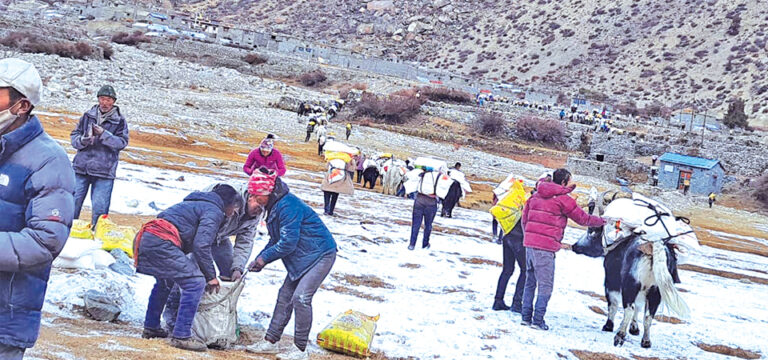
Food grains transported by helicopter have been distributed to locals in the trans-Himalayan village of Limi.
Even though the food grains reached the place two days ago, a joint meeting of the three villages was held on Sunday and the food was distributed in Halji village.
Paljor Tamang, Ward Chairperson of Namkha Rural Municipality-6 Limi, said that the food grains provided by the government were distributed to 147 households of Til, Halji and Jhang villages on Sunday.
He said that the people of Limi got one-and-a-half quintals of food grains, including five sacks of flour and one sack of rice weighing 25 kg each. The locals, who got the food after a gap of one year, have been greatly relieved because of the distribution.
The people of each household had come to Halji to receive food. Locals from the two villages had to transport the food by horses and yaks. Locals have felt the presence of the government in remote regions after it provided the needy ones with the much-needed food grains, he said.
Helicopters flew more than 16 flights from Simkot to transport 235 quintals foods grains to Limi, said Ganesh Acharya, Humla Chief District Officer. Out of 235 quintals food grains, 200 quintals were supplied from Hilsa and 35 quintals from Simkot, he said.
Acharya said that 260 quintals of food grains were still available in Hilsa and that all food grains had been distributed free of cost.
A 27-member team from Limi had reached Simkot two weeks ago after the region started facing food shortage.
Special initiative was taken by Karnali Chief Minister Jeevan Bahadur Shahi, MP Chakka Bahadur Lama and Rangmati Shahi and Chief District Officer Acharya.
Ward chairperson Tamang had reached Kathmandu to seek support for the Limi people, as a result of which the Ministry of Home Affairs had arranged funds from the rescue fund for the transportation of food grains.
Although a quota of 500 quintals of food grains has been fixed for Limi for the current fiscal year with the establishment of Food Management and Trading Company, that didn’t translate into reality until recently.
The food grains have to be transported from Hilsa along Kathmandu, Kerung and Tibetan routes.
Source : TRN,






